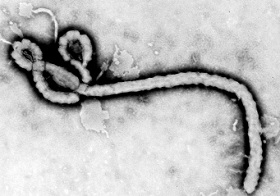Chance of a global Ebola epidemic is small
The new Ebola outbreak in Guinea raises many questions about the deadly virus. More than a hundred people have been killed and even more are infected. According to the World Health Organization (WHO) this is “one of the most challenging outbreaks of Ebola, which we ever had to deal with.” The severity of the infection and the outbreak is large, but it will not lead to a global epidemic, according to dr. Byron Martina, virologist at the Erasmus MC.
In Guinea, there are more than 50 infections with the Ebola virus confirmed in the lab. It is estimated that there are more than 150 people infected with the virus, of which 95 probably with a lethal outcome. In addition, there infections have been reported in Liberia, a country near Guinea. According to Martina it is a true outbreak. “Normally, the Ebola virus isn’t circulating among people. Therefore, we speak of an outbreak whenever a human gets infected, no matter how small the numbers are.” The first registered outbreak of Ebola was in 1976.
Spread
Unique to the outbreak in Guinea, is the spread of the virus to other countries and regions. Previous outbreaks were centered in a particular area. According to Martina, this is primarily dependent on the precautions taken to prevent the virus from spreading. “From previous outbreaks, we know that proper protection of the nursing staff and family members and close monitoring of individuals, who have had contact with the patient are important steps to take to stop an outbreak of Ebola and prevent the virus from spreading.”
However, the probability of a global epidemic is small, according to the virologist. “As far as we know, there is little of no spread of Ebola through the air. In addition, the virus only becomes transferred when the patient has symptoms. So other people can only acquire the virus late after infection.” Martina points out, though, that we don’t know enough about what strain of Ebola causes the outbreak, to make an analysis of the spreading risk. “To estimate the further threat , it is important to determine the virus strain responsible for the outbreak as soon as possible.” Because of the action taken by the international communities and the WHO, the estimation is that this outbreak will last no longer than 4 months.
Bats
The Ebola virus is a zoonotic disease, which means that the virus is transmitted to humans by (wild) animals. The virus spreads form person-to-person through contact with body fluids. In all likelihood, the bat is the reservoir of the virus. However, there is still much uncertainty about the exact source of the outbreak, according to the virologist. “The virus is especially common in Central and West Africa. We know that certain species of bats are likely to act as a reservoir. Whether other species play a role as an intermediate host is not clear. We do not know how the virus was introduced in Guinea. It might be due to migrating bats, but that's unlikely. Another, and more likely option is the contact or consumption of infected bats or other wild animals. Bats are eaten a lot in many African countries.”
Infection with the Ebola virus initially leads to flu-like symptoms such as fever, vomiting and diarrhea, severe headaches and muscle pain. Approximately half of the patients develop additional internal bleedings. On average, 48 to 72 hours after the emergence of the first symptoms, 25 to 90 percent of people die.
Vaccine
Because of the uncertainty about the origin of the virus, it is not clear how, when and why the virus suddenly 'pops up'. “As long as we do not know these things, it remains difficult to explain and predict outbreaks. If we know where the virus is hiding between outbreaks, we can better anticipate outbreaks. This would also help to determine the actions needed to stop it.”
For the time being, there is no vaccine or cure for the virus. Canadian researchers have published a study in 2012 in which they tested a cocktail of antibodies in infected monkeys. “The results were encouraging. But before the cocktail can be used in humans, it must be clear whether it is safe. I estimate that it will take a couple of years before the safety and efficacy of the drug in humans is known”, says Martina. After that, it is waiting for a new outbreak before the product can be tested.
Source: WHO







